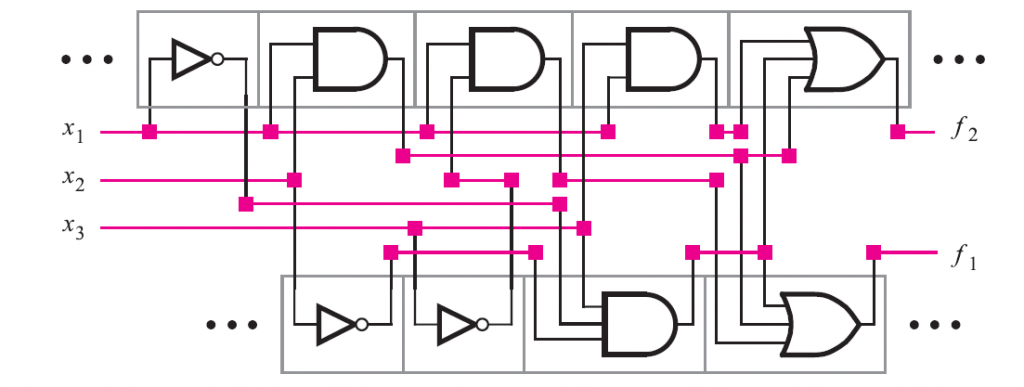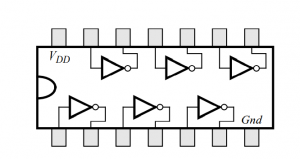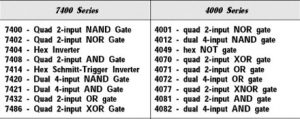
Introduction
In this article, I have discussed about Standard Chips for Digital Logic Design. Until the mid-1980s, connecting many chips with a small number of logic gates on each was a common practice. Integrated circuits known as “standard chips” are made in large quantities to carry out frequently required electrical tasks. Over the years, they have shown to be extremely beneficial in circuit design. To carry out a particular task, engineers and technicians can connect these components to various elements of a broader circuit.
The logic gates AND, OR, NOT, NAND, NOR, XOR, and XNOR, which come in a variety of various forms of logic, are some of the more popular uses for standard chips. Many of these have been developed as 7400 or 4000 series chips (these part numbers are printed on the top of the chip casing). Pins or leads are the terms used to describe the chip’s external connections. The chip is powered by connecting VCC and Gnd through two pins. The inputs and outputs of each individual gate are connected using the additional pins.
7400 Series Chips
The 7400 series chips are constructed using three primary types of technology. Some of the more traditional designs are represented by chips with codes that start with 74LS. A maximum frequency of roughly 35 MHz is achieved by using TTL (transistor-transistor logic) in its construction. One of its outputs may drive up to ten 74LS inputs or fifty 74HCT inputs, and their input voltage is a constant 5 V. Its guiding principle is known as “fan-out. 74HCT chips were developed using the CMOS technology, however, they are compatible with TTL (complementary metal-oxide semiconductor). The input voltage for these devices is around 5 V. One output may drive up to fifty 74HCT, HC, or other CMOS inputs at their maximum frequency of 25 MHz, but only ten 74LS inputs. The high-speed CMOS 74HC series chips operate at a maximum frequency of 25 MHz and with input voltages ranging from 2 to 6 V.


4000 Series Chips
The CMOS technology used to create the 4000 series processors only allows for a maximum frequency of roughly 1 MHz One output may drive up to fifty CMOS, 74HCT, or 74HC inputs, but only one 74LS input and their input voltage can range from 3 to 15 V. The chip merely uses a few microwatts of power, whether it is in the 4000 or 7400 series. Some popular standard chips are listed in above Figure (a).
Each type’s real purpose is detailed in a datasheet, which also contains instructions on how an IC works. A datasheet could contain details like power requirements, the truth table, and IC characteristics, to name just a few. The component number, the IC’s gate type, the schematic, and the truth table are often included on the first page of a datasheet. Several crucial operational factors are as follows:
- VCC: the supply voltage necessary to run the IC
- VIHMIN: IC must have a minimum input voltage of 1 to detect a “high input value.”
- VILMAX: The highest input voltage necessary for an integrated circuit to detect “low input value, or 0”
- tPLH (propagation delay time): Duration of the IC’s transition from a low-level to a high-level output
- tPHL (propagation delay time): Duration of the IC’s high-level output to low-level output transition

The “74” Sub-families of Integrated Circuits
With one exception, the standard chips are no longer often utilized in practice because of their limited capacity for logic. Buffer-containing standard chips are found in many contemporary products. Logic gates called buffers are frequently employed in circuits to increase their speed. Figure 3 shows a buffer chip as an illustration.
For the 74244 chip, which has eight tri-state buffers, only the pin numbers of the package pins linked to the buffers are shown. The package includes 20 pins, which are numbered similarly to how they are in Figure 3. On pins 10 and 20, respectively, connections for ground and VDD are available. There are also several additional buffer chips. The 162244 chip, for instance, contains 16 tri-state buffers.
It belongs to a group of gadgets that resemble 7400-series semiconductors but have twice as many gates per chip. The most common of the several packaging for these chips is the small-outline integrated circuit (SOIC) package. While the form of a SOIC package is similar to that of a DIP, the SOIC is physically much smaller.
Method of Categorizing Chips Based on Their Size
A method of categorizing chips based on their size has developed throughout time as integrated circuit technology has advanced. Only a small number of logic gates are included in the first manufactured chips, including those in the 7400-series. Small-scale integration is the name of the process utilized to make these chips (SSI).
Chips with a bit more logic circuitry, generally between 10 and 100 gates, are considered to have medium-scale integration (MSI). Up until the mid-1980s, large-scale integration was the term used to describe chips that were too big to be considered MSI (LSI). The idea of categorizing circuits based on their size has proven less useful in recent years. Many thousands or millions of transistors are present in the majority of integrated circuits nowadays.
These enormous chips, regardless of their precise size, are considered to have been produced using very large-scale integration (VLSI) technology. It’s becoming more common for digital hardware manufacturers to pack as much circuitry as they can onto a single chip. As a result, VLSI technology is utilized to build the majority of today’s chips, while previous chip types are very sometimes employed.

The “40” Sub-families of Integrated Circuits
The 4000 series of devices, like the 74, have a common numbering scheme that may be useful to recall what each family does. The 40 prefix is what makes them famous. CMOS devices are sometimes used in later 74 devices because of their high speed and low power uses, but their major drawback is their sensitivity to ESD (static electricity). Additionally, the supply voltage range can occasionally be more of a drawback than a benefit. The 4000 series is becoming less and less common and is being incorporated into other families as modern electronics go to lower voltages to increase switching speeds and reduce power consumption.
Also read here
- What are the Practical Aspects of Digital Circuit Design?
- What are the Transmission Gates?
- half adder and full adder circuit design
- half subtractor and full subtractor circuit design
- How to simplify a Boolean function using Karnaugh map (k-map)?
- What are the flip flops and registers in digital design?
- What is the magnitude comparator circuit? Design a 3 bit magnitude comparator circuit
- How to design a 4 bit magnitude comparator circuit?
- how to represent Boolean functions in class of reversible logic circuits?
- What are number systems in computer?
- Number System Conversions – Briefly Explained
- How to design Half adder and Full adder circuits?
- What are the decoders? how are they different from encoders?
- What is binary arithmetic? How to add, subtract, multiply and divide two binary numbers?
- How many hundreds are there in 1000?
- What are the synchronous counters? Explain with an example
- what are the BCD and binary ripple counters?